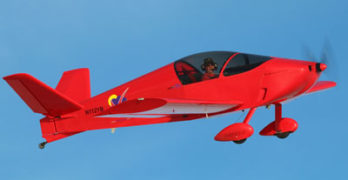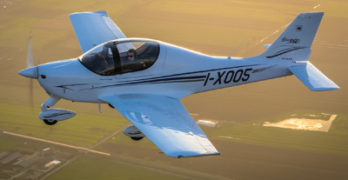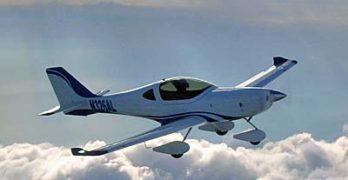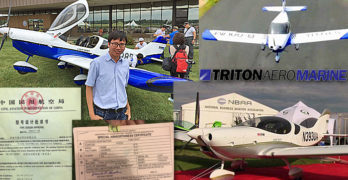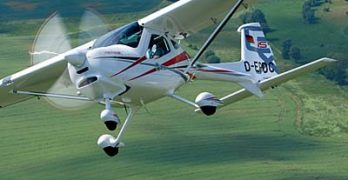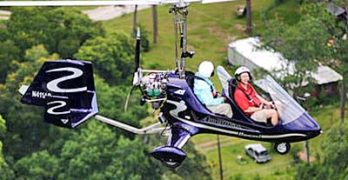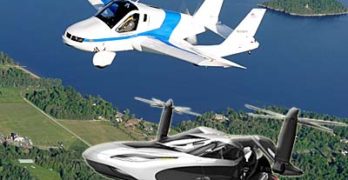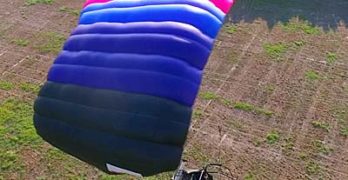Pardon a little fun in the title. I recalled the line long ago attributed to Henry Ford, “You can have any color [Model T] you want as long as it’s black.”
Sonex Aircraft had so regularly brought bright yellow airplanes to airshows, folks could be excused for thinking that was the only color available. Of course, since the company sells kit aircraft, you can have whatever color you wallet can handle.
Why wouldn’t you want a red one? The color works for Ferrari.
Indeed, the newest model from Sonex is not about the color at all. “We just wanted to separate the new B models from the earlier models,” said General Manager, Mark Schaible. Changing up their airshow model paint job may stimulate people to look more closely… exactly the idea.
Sonex Aircraft debuted a new B-Model design for the Sonex and Waiex models earlier this year at Sun ‘n Fun 2016.
Search Results for : CT AND hand control
Not finding exactly what you expected? Try our advanced search option.
Select a manufacturer to go straight to all our content about that manufacturer.
Select an aircraft model to go straight to all our content about that model.
Tecnam Upgrades Popular Sierra, Now Called Mark 2
Fourteen years ago, light aviation leader Tecnam brought their only low wing, the Sierra, to market. It went on to become one of their most popular airplanes …and that’s truly saying something since the Italian company has a broad line of beautiful airplanes.
On the 65th anniversary of this company founded in 1948, Tecnam brought their sparkling new Astore to the market (so named in honor of the very first aircraft the company offered). At its debut most thought Sierra had been replaced by Astore, perhaps never to be seen again. Happily, that is not the case.
An old line is: Nothing succeeds like success. Therefore, given the impressive run of Sierra the First, and even with the Astore, Sierra Mark 2 may be utterly logical. “The market is always demanding greater comfort and more features,” says Tecnam Managing Director, Paolo Pascale, “so improving and updating our product is a must.”
The Capua, Italy-based company announced, “Tecnam has introduced a substantially updated and improved Mark 2 version of the company’s popular P2002 Sierra.” The model name P2002 indicates the original design was created that year.
A Lightning Bolt You Can Catch: LS1
Over and over I’ve heard about the cost of Light-Sport Aircraft. Indeed, some are approaching $200,000 and at least four have smashed through that barrier (CubCrafters, Icon, Terra Fugia, and Lisa). Now, I’ll grant you $200K+ for a two seater is fairly breathtaking. But…
In each case above and for those many others in the $125-175,000 range, we’re talking about real money. Balancing that, all LSA in the $125K and up price range are impressive aircraft with more bells and whistles than most GA airplanes (and even some airliners!). They are hand-built works of art using carbon fiber; digital cockpits; wide, luxurious cockpits with amazing visibility; and emergency airframe parachutes. They are marvels with autopilot, synthetic vision, gas-sipping (and very modern) engines, and so much more.
Virtually every LSA — no matter how impressively equipped — still remains at half to one third or even less of the cost of even the most affordable Part 23 general aviation airplanes.
Newest SLSA Developed & Fabricated In China
The newest owner of a SLSA Special Airworthiness certificate is Triton AeroMarine for their Skytrek. First seen at Oshkosh six weeks ago, boss Thomas Hsueh said he would have approval shortly and he was true to his word. The proof came at the just concluded Midwest LSA Expo 2016 in Mt. Vernon, Illinois where Thomas and his young team brought the first SLSA version of Skytrek
Yes, I know Skycatcher was the first designed-in-the-USA, made-in-China Special LSA. The two approaches differ in two ways, however, as Triton did their work and test flying in China where Cessna did all their development in Wichita, Kansas and merely sublet the production work to Shenyang (a large state-owned aircraft producer). Triton, a private non-state company, has a corporate base in Washington State. Its factory is in Zhuhai, China, home to a well establish airshow. The other difference is that Skytrek also has Type Design Approval in China so it has passed inspection by two sets of aviation authorities.
BOT Aircraft — Speed Cruiser & D-Motor
BOT Aircraft is the producer of the Speed Cruiser LSA, which we reviewed earlier. In this video shot at Aero Friedrichshafen, we explore the company’s work with the D-Motor aircraft engine. As the launch customer for the powerplant, B.O.T. boss Reiner Tauern reviews with us why he chose the new engine and what buyers might expect of it. In addition, B.O.T. also supports hand controls for pilots who have special needs.
Magnaghi Aeronautica — Sky Arrow (0712)
Sky Arrow, now available in blue and white (you hear the humor about “Any color you like…” on the video) from Magnaghi Aeronautica, the large Italian aerospace company that took over the Sky Arrow design and manufacturing after the previous company failed. This beautiful flying Light-Sport Aircraft was in limbo for a few years but Magnaghi rescued it. Sky Arrow has often been used for training disabled persons thanks to hand controls. Here what changed after Magnaghi took over.
Remos GXiS — A Mercedes of LSA
Oshkosh is on! OK, not today. The big show starts tomorrow, but you wouldn’t know it as airplanes are already arriving in droves and the grounds are rapidly filling. Time for EAA’s summer celebration of flight to begin!
Although I’m a longtime regular, today I did something I’ve never done. I flew out of KOSH and then returned. If you’ve never flown into Oshkosh during AirVenture, you may not know what an experience such an arrival can be. This is the world’s busiest airport for one week. Airplanes arrive every few minutes and all of them do so in a unique, follow-the-plane-in-front-of-you method where no pilot uses the radio. Departing was fairly simple. Arriving is always an eye-opening experience.
I did my departure and reentry with Remos PR & Marketing guy Patrick Holland-Moritz, a former German aviation magazine writer. We flew in the brand new Remos GXiS. Flying into Oshkosh was a repeat treat for me, but I think Patrick was blown away by the flowing river of airplanes of all types.
Flying America’s First Homegrown Modern Gyroplane
Once upon a time… gyrocopters were an American invention. Igor Benson was such an important pioneer that many fixed wing pilots refer to all such flying machines as “Bensen gyros.” Starting in the 1950s, he hit on a good combination of ideas that made the new sector flourish… for a time.
Gyros are small rotary winged aircraft that resemble helicopters in some ways — all have a spinning wing above the occupants. However, gyros work by the air moving across the blades of the rotor disk; their rotors are not powered. Most readers likely don’t need a technical discussion. Suffice it to say gyros and helos are far from the same animal no matter how much they might look like one another.
Yet in the last couple decades things began to change, dramatically. Perhaps to accentuate their differences, modern producers prefer “gyroplanes” while the older Bensen types are often referred to as “gyrocopters.” The old and new are different in important ways.
Flying Car Racing Event & Terrafugia New Weight
If my title confuses you, regrets. The two are related in my mind but not in present-day fact. Nonetheless, I found both interesting and hope you do, too.
First, the fact. Terrafugia, of current Transition Roadable Airplane or flying car fame, won a weight exemption up to 1,800 pounds. This blows past the 1,680 pound exemption won by Icon Aircraft for their A5 LSA seaplane (only 1,510 pounds of which they chose to use). Earlier Terrafugia was granted an exemption to the seaplane LSA weight of 1,430 pounds but that didn’t prove to be enough.
A problem, perhaps the major problem, for Terrafugia is contained in the Federal Motor Vehicle Safety Standards (and let’s be just as government as we can be to go with the inescapable abbreviation of FMVSS). You cannot take to the air with any airplane heavier than an ultralight vehicle (254 pounds empty plus certain exceptions) without satisfying lengthy FAA regulations and you cannot put a non-kit car on the road without meeting the considerable requirements of FMVSS.
“Two Engine” SkyRunner Wins Special LSA Status
Please again welcome Powered Sport Flying publisher, Roy Beisswenger, who sent the following story on the exciting new powered parachute from SkyRunner. —DJ
I have been actively following SkyRunner for more than a year. The U.S. start-up company is rare in the Light-Sport world. The company’s MK 3.2 entry is the first American two-seat powered parachute manufacturer to launch since the LSA regulation was issued.
Sadly, the SP/LSA rules actually ran most of the powered parachute manufacturers, dealers, instructors, and even pilots from the early 2000s out of the business and sport. It is refreshing to watch a company buck that trend!
Creating a powered parachute from the ground up is a challenge, and to build one that doubles as mighty gnarly all-terrain vehicle is even more of a challenge. SkyRunner’s team did it more than once. They began their effort with a single-place model (photo) that owner and developer Stewart Hamel initially funded.
- « Previous Page
- 1
- …
- 27
- 28
- 29
- 30
- 31
- …
- 61
- Next Page »


